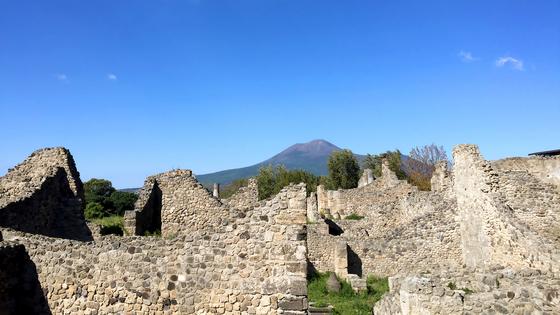Rick Steves’ Europe: Reflecting on ruin at Vesuvius and Pompeii
The ancient city of Pompeii – famously ruined in AD 79 when mighty Mount Vesuvius blew its top – is one of Italy’s most popular tourist attractions. Few visitors know that you can easily visit the summit of the towering volcano. And those who do enjoy a commanding view.
You can get to Vesuvius with a train/bus/hike journey. You start by riding a rickety but reliable commuter train from Naples or Sorrento (because it circles under Vesuvius, the train is called the Circumvesuviana). From near the Pompeii stop, public buses, trolley trams, and monster-truck-like shuttle buses take visitors up the volcano to the end of the road. From there, it’s a moderately steep 30-minute hike to the desolate, lunar-like summit. (Before you set out, check locally whether a timed reservation is required.)
At the crater’s edge, steaming vents are a reminder that while Vesuvius is quiet today, it’s just taking a geological nap. The last eruption was in 1944, and it’s only a matter of when, not if, it will erupt again. Italian authorities close Vesuvius to visitors when they think the volcano is acting too frisky.
A hike around part of the crater’s lip comes with spectacular vistas of Naples, its sweeping bay, and Pompeii. As I listen to the wind and occasional cascade of rocks tumbling into the crater and observe wisps of steam, I like to imagine the scene nearly 2,000 years ago, when Vesuvius sent a mushroom cloud of ash, dust, and rocks 12 miles into the sky for 18 hours straight. With the wind blowing the cloud southward, white-gray ash settled like a heavy snow on Pompeii. Most of the city’s 20,000 residents fled as roofs and floors began collapsing.
But then, suddenly, the eruption became more fiery. A red-hot avalanche of rock and ash raced down the mountainside at nearly 100 miles per hour. Pompeii and the 2,000 unlucky souls who had stayed behind were buried, leaving their bodies encased in volcanic debris. As the bodies decomposed, they left hollow spaces. Centuries later, archaeologists detected these spaces and gently filled them with plaster, creating molds that chillingly capture their anguished last moments.
Today, ongoing excavations of once booming Pompeii offer the best look anywhere at ancient Roman life. Back then, Rome controlled the entire Mediterranean Sea, and Pompeii was an important, big port town. Not rich, not poor, Pompeii was middle class. And because it was a port, it was a sailor's quarter, with lots of bars, public baths, brothels, restaurants, and places of entertainment.
The best way to understand Pompeii is to walk the site (it's about $20 for entry; for my free audio tour of the site, see www.ricksteves.com/audioeurope). In good Roman style, the city was well organized, contained by its walls with a grid street plan. Back in antiquity, most of Pompeii’s streets would have been lined with stalls and jammed with customers from sunup to sundown. Chariots vied with shoppers for street space.
There were no posh neighborhoods in Pompeii. The well-off and not-so-well-off mixed it up as elegant houses existed side by side with simpler homes. Pompeii’s best-preserved dwelling is the House of the Vetti, the bachelor pad of two wealthy merchant brothers. Its atrium provides a peek at the typical layout of a mansion. Richly frescoed entertainment rooms ring the central courtyard.
One of Pompeii’s most impressive aspects is how abundant water was. In this well-plumbed city, lead pipes funneled water from an aqueduct-fed reservoir at the high end of town directly to neighborhood water tanks. With the tanks installed just below the level of the reservoir, gravity did the work – and ensured good water pressure. Fountains provided a social center at street intersections, and a steady stream of water flushed the chariot-rutted streets clean. Pompeii’s citizens enjoyed relaxing at its impressive public baths.
For archaeologists, Pompeii was a shake-and-bake windfall. They first got to work at the site back in the 1700s – before Italy was united. The local king who ruled from Naples demanded: “Bring me the best of whatever you find!” That’s why, as impressive as the ancient city is, the finest art and artifacts of Pompeii ended up back in Naples at the Archaeological Museum.
For lovers of antiquity, this museum by itself makes Naples a worthwhile stop. This important collection offers the best possible peek into the art of Pompeii, ranging from supersized statues and exquisite mosaics to the most intimate details of everyday life. All the artifacts are a testament to the ultimate irony of Vesuvius: Even as the volcano’s fury destroyed Pompeii by burying the city, it also preserved most of what the world knows about this ancient wonder.
========
(Rick Steves (www.ricksteves.com) writes European guidebooks, hosts travel shows on public TV and radio, and organizes European tours. This column revisits some of Rick's favorite places over the past two decades. You can email Rick at rick@ricksteves.com and follow his blog on Facebook.)
©2024 Rick Steves. Distributed by Tribune Content Agency, LLC.
(c)2024 RICK STEVES DISTRIBUTED BY TRIBUNE MEDIA SERVICES, INC.














Comments